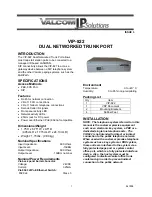
Multicast VLAN Registration
3-265
3
Multicast VLAN Registration
Multicast VLAN Registration (MVR) is a protocol that controls access to a single
network-wide VLAN most commonly used for transmitting multicast traffic (such as
television channels or video-on-demand) across a service provider’s network. Any
multicast traffic entering an MVR VLAN is sent to all attached subscribers. This
protocol can significantly reduce the processing overhead required to dynamically
monitor and establish the distribution tree for a normal multicast VLAN. This makes
it possible to support common multicast services over a wide part of the network
without having to use any multicast routing protocol.
MVR maintains the user isolation and data security provided by VLAN segregation
by passing only multicast traffic into other VLANs to which the subscribers belong.
Even though common multicast streams are passed onto different VLAN groups
from the MVR VLAN, users in different IEEE 802.1Q or private VLANs cannot
exchange any information (except through upper-level routing services).
General Configuration Guidelines for MVR
1. Enable MVR globally on the switch, select the MVR VLAN, and add the multicast
groups that will stream traffic to attached hosts (see “Configuring Global MVR
Settings” on page 3-266).
2. Set the interfaces that will join the MVR as source ports or receiver ports (see
“Configuring MVR Interface Status” on page 3-270).
3. Enable IGMP Snooping to a allow a subscriber to dynamically join or leave an
MVR group (see “Configuring IGMP Snooping and Query Parameters” on
page 3-253). Note that only IGMP version 2 or 3 hosts can issue multicast join or
leave messages.
4. For multicast streams that will run for a long term and be associated with a stable
set of hosts, you can statically bind the multicast group to the participating
interfaces (see “Assigning Static Multicast Groups to Interfaces” on page 3-271).
Multicast Router
Layer 2 Switch
Multicast Server
PC
TV
Set-top Box
TV
Set-top Box
Satellite Services
Service
Network
Source
Port
Receiver
Ports
Summary of Contents for iES4028F
Page 1: ...iES4028F 4028FP 4024GP ...
Page 4: ...iv This page is intentionally left blank ...
Page 10: ...x This page is intentionally left blank ...
Page 28: ...Contents xxviii This page is intentionally left blank ...
Page 32: ...Tables xxxii This page is intentionally left blank ...
Page 46: ...Introduction 1 10 1 This page is intentionally left blank ...
Page 336: ...Configuring the Switch 3 280 3 This page is intentionally left blank ...
Page 688: ...Command Line Interface 4 352 4 This page is intentionally left blank ...
Page 702: ...Glossary Glossary 8 This page is intentionally left blank ...
Page 710: ...Index 8 Index This page is intentionally left blank ...
Page 711: ...This page is intentionally left blank ...
Page 712: ...iES4028F 4028FP 4024GP ...
















































